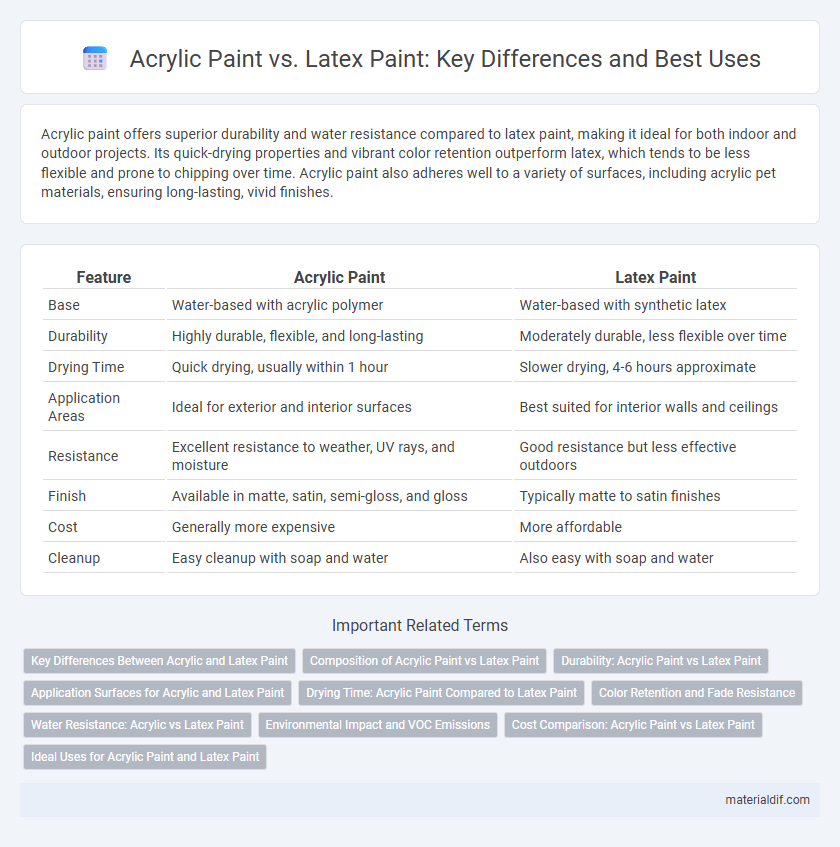Acrylic paint offers superior durability and water resistance compared to latex paint, making it ideal for both indoor and outdoor projects. Its quick-drying properties and vibrant color retention outperform latex, which tends to be less flexible and prone to chipping over time. Acrylic paint also adheres well to a variety of surfaces, including acrylic pet materials, ensuring long-lasting, vivid finishes.
Table of Comparison
| Feature | Acrylic Paint | Latex Paint |
|---|---|---|
| Base | Water-based with acrylic polymer | Water-based with synthetic latex |
| Durability | Highly durable, flexible, and long-lasting | Moderately durable, less flexible over time |
| Drying Time | Quick drying, usually within 1 hour | Slower drying, 4-6 hours approximate |
| Application Areas | Ideal for exterior and interior surfaces | Best suited for interior walls and ceilings |
| Resistance | Excellent resistance to weather, UV rays, and moisture | Good resistance but less effective outdoors |
| Finish | Available in matte, satin, semi-gloss, and gloss | Typically matte to satin finishes |
| Cost | Generally more expensive | More affordable |
| Cleanup | Easy cleanup with soap and water | Also easy with soap and water |
Key Differences Between Acrylic and Latex Paint
Acrylic paint is water-based and composed of acrylic polymer emulsions, offering superior flexibility and durability compared to latex paint, which primarily consists of synthetic polymers like styrene-butadiene or vinyl acrylic. Acrylic paint provides better adhesion on various surfaces and resists cracking and peeling, making it ideal for exterior applications, while latex paint is often preferred for interior walls due to its ease of cleanup and lower cost. The key differentiator lies in acrylic's enhanced weather resistance and vibrant color retention, which outperform latex in long-term performance.
Composition of Acrylic Paint vs Latex Paint
Acrylic paint consists of acrylic polymer emulsions, providing strong adhesion and flexibility on various surfaces, while latex paint typically contains water-based latex resins with vinyl or acrylic blends for easier cleanup and quick drying. The molecular composition of acrylic paint allows it to form a durable, water-resistant film that withstands weathering better than traditional latex paint. Latex paint's composition is generally more suited for interior applications due to its less robust polymer structure and lower resistance to environmental factors.
Durability: Acrylic Paint vs Latex Paint
Acrylic paint offers superior durability compared to latex paint due to its flexible, water-resistant polymer base that resists cracking, peeling, and fading over time. Its excellent adhesion to a variety of surfaces ensures longer-lasting protection in harsh weather conditions. Latex paint, while easier to clean and more affordable, typically lacks the same level of resilience, making it less ideal for exterior applications requiring extended durability.
Application Surfaces for Acrylic and Latex Paint
Acrylic paint is ideal for porous surfaces such as wood, canvas, and masonry due to its superior adhesion and flexibility. Latex paint excels on interior walls, drywall, and ceilings, providing durability and easy cleanup with water. Both paints adapt well to various home improvement projects, but acrylic's water-resistant properties make it suitable for exterior applications.
Drying Time: Acrylic Paint Compared to Latex Paint
Acrylic paint typically dries faster than latex paint, with most acrylic paints drying to the touch within 20 to 30 minutes, while latex paints may take up to one hour or more. The rapid drying time of acrylic paint makes it ideal for projects requiring multiple coats in a short period. Latex paint's slower drying time allows for easier blending and leveling, but may extend the overall project duration.
Color Retention and Fade Resistance
Acrylic paint demonstrates superior color retention and fade resistance compared to latex paint due to its pigment-rich formula and UV-resistant properties. The molecular structure of acrylic resins provides a stronger barrier against environmental factors such as sunlight and moisture, ensuring vibrant colors last longer. As a result, acrylic paint is often preferred for exterior applications where long-term durability and color stability are critical.
Water Resistance: Acrylic vs Latex Paint
Acrylic paint offers superior water resistance compared to latex paint due to its higher concentration of acrylic polymers, which form a durable, flexible film that repels moisture effectively. Latex paint, primarily water-based with fewer acrylic components, tends to absorb water more readily, making it less ideal for areas exposed to constant moisture or outdoor conditions. For applications requiring robust water resistance, especially in exterior or high-humidity environments, acrylic paint provides enhanced protection and longevity.
Environmental Impact and VOC Emissions
Acrylic paint generally has lower volatile organic compound (VOC) emissions compared to latex paint, making it a more environmentally friendly option for indoor applications. Acrylic paint is water-based and contains fewer harmful solvents, reducing its impact on air quality and human health. Latex paint also tends to have higher levels of synthetic additives and plasticizers, which contribute to greater environmental pollution during manufacturing and disposal.
Cost Comparison: Acrylic Paint vs Latex Paint
Acrylic paint typically costs more per gallon than latex paint due to its superior durability and faster drying time, with prices ranging from $20 to $70 compared to latex's $15 to $40. Despite the higher upfront expense, acrylic paint often requires fewer coats and less maintenance over time, potentially offsetting initial costs. Latex paint remains the budget-friendly option for large interior projects where cost efficiency is a primary concern.
Ideal Uses for Acrylic Paint and Latex Paint
Acrylic paint is ideal for artists and craftspeople due to its fast drying time, vibrant colors, and excellent adhesion to various surfaces like canvas, wood, and metal. Latex paint is best suited for home interiors and exteriors, offering durability, ease of cleanup, and resistance to moisture, making it perfect for walls, ceilings, and siding. Choosing between acrylic and latex paint depends on the project requirements, surface type, and desired finish longevity.
Acrylic Paint vs Latex Paint Infographic

 materialdif.com
materialdif.com